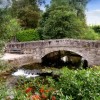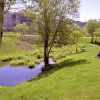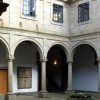- Accede I
- Regístrate I
- carrito
Río Sarela y Barrio de O Carme de Abaixo
Desde la rúa de San Lourenzo, atravesando la Ruela dos Gatos, se llega hasta la ribera del río Sarela y a la antigua fábrica de curtidos del barrio de O Carme de Abaixo , hoy rehabilitada como lujoso complejo residencial.
Esta zona recuerda la importancia económica que durante siglos tuvieron los ríos. El Sarela, a pesar de su corto recorrido, que nace y muere en el municipio de Santiago, sirvió de asiento a unas ocho fábricas de curtidos . Aunque la mayoría de ellas están hoy en ruinas, todavía conservan, inequívocas, las huellas de su pasado. En estas industrias artesanales, que tuvieron su esplendor durante el siglo XIX y hasta la mitad del XX, se completaba todo el tratamiento de las pieles hasta que estaban listas para ser convertidas en zapatos, correas, cartucheras...
Al lado de la antigua fábrica de O Carme de Abaixo, y unido a ella por un pasadizo a nivel, el convento de las Oblatas , conjunto de edificios decimonónicos recuperado como hotel de lujo. Las Oblatas, también llamadas 'arrepentidas', eran las monjas que tradicionalmente acogían a las mujeres de vida ‘licenciosa'. Su ubicación en esta zona de la ciudad resultaba muy oportuna por su proximidad a la zona que tradicionalmente ocuparon 'las mujeres comunes': el barrio de O Pombal . Considerado hasta hace unos años una zona semirural y marginal, por asentarse en ella las 'casas de mancebía' de la ciudad, este barrio ha sido objeto, de un tiempo a esta parte, de una serie de actuaciones urbanísticas que lo han convertido en un área privilegiada de expansión de la ciudad. ..
En la confluencia de los barrios de O Pombal y de O Carme de Abaixo, al lado del río y del viejo puente, está la capilla de O Carme de Abaixo , discreto santuario del siglo XVIII.

























